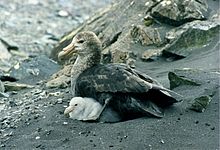Date:December 21, 2015
Source:British Antarctic Survey
 A fifty year study of the charismatic seabird, the southern giant petrel, on the Antarctic island of Signy shows its population has halved and its breeding success has declined in the last 10-20 years. The results by scientists at British Antarctic Survey (BAS) are published this month in the journal Polar Biology online.
A fifty year study of the charismatic seabird, the southern giant petrel, on the Antarctic island of Signy shows its population has halved and its breeding success has declined in the last 10-20 years. The results by scientists at British Antarctic Survey (BAS) are published this month in the journal Polar Biology online.
Southern giant petrels are large, colonially-nesting seabirds with wingspans of over 2 m capable of long-distance ocean travel. They feed on prey ranging from crustaceans (including Antarctic krill), squid and fish at sea, to penguin and seal remains on land. Most birds breed for the first time only when they are between six and ten years of age, and they produce at most one chick per year.
Scientists have studied the giant petrels breeding at Signy Island -- in the South Orkney Islands (60°S) -- since 1968. Twenty years ago, a structured monitoring program was introduced to keep a closer track of numbers of breeding birds and how many chicks fledged each season. These surveys -- the most detailed on this species in the South Orkneys -- have now revealed that breeding success has declined substantially, from 60% in 1996 to 40% in 2015 in selected study colonies. Whole-island counts show that following an increase in breeding numbers from the mid 1980s to the mid 2000s, the population has halved from over 5800 to around 2600 nesting birds since 2005.
No comments:
Post a Comment